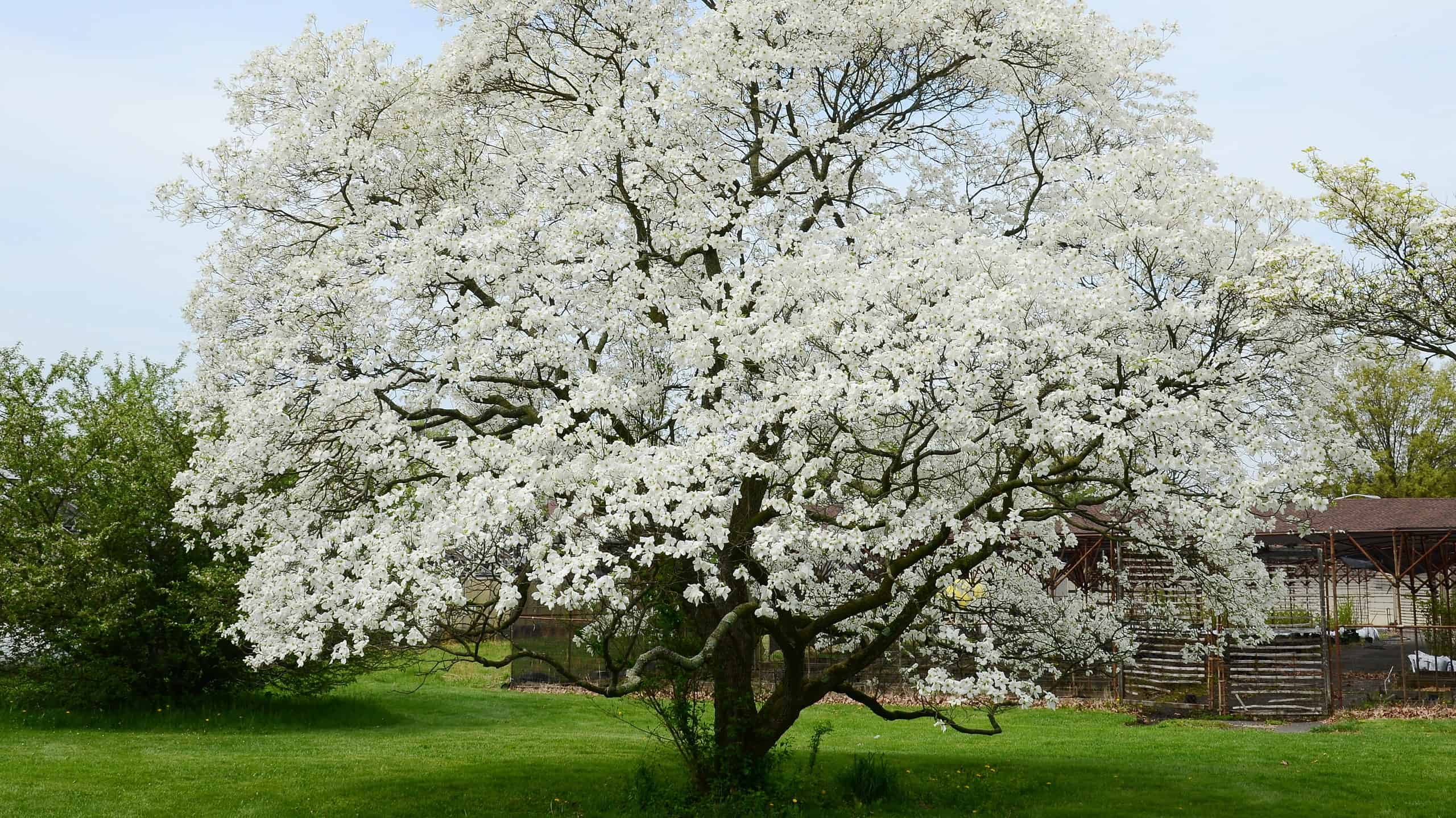An attractive flowering tree often used as bonsai is the dogwood tree, a species that grows comfortably in many locations around the world. They do best as outdoor bonsai and admittedly are a bit more challenging than the average beginner should attempt. They are, however, one of the most beautiful flowering bonsai trees you can grow.

©Walter Pall/Shutterstock.com
What Makes a Dogwood Good for Bonsai?
There are several species of dogwood that have been used as bonsai, though the most popular tends to be the cornelian cherry (Cornus mas). The tree produces edible fruit, gorgeous blooms, and make overall attractive bonsai specimens. They’re frost hardy, as well. However, dogwood are not the easiest trees to bonsai and aren’t typically recommended for beginners.
Dogwood Classification and Names
The dogwood tree belongs to a genus Cornus, with 30 to 60 species of woody plants or trees in the family Cornaceae. The tree is fairly easy to distinguish by its blossoms, berries, and distinctive bark. Most of the species are deciduous, though a few are evergreen shrubs or trees, and others are herbaceous perennial subshrubs.
The common flowering dogwood that is most frequently cultivated is the Cornus florida. Other common varieties include Cornus anguinea, Cornus nuttallii, Cornus kousa, Cornus canadensis and Cprnus suecica.
The word ‘cornus’ is Latin for cornel tree, commonly known as Cornus mas, or the cornelian cherry. The name cornel dates back to the mid-1500s, basically meaning cornel cherry or “horn.” The term dog-tree was common before 1548 and then ultimately became dogwood by 1614, with the fruit known as dogberries or houndberries and the tree also nicknamed Hound’s tree. These are not to be confused with the houndberries that are in the nightshade family. An older English name for the tree is also the Whipple tree, appearing as such in Geoffrey Chaucer’s Canterbury Tales.
Dogwood Description
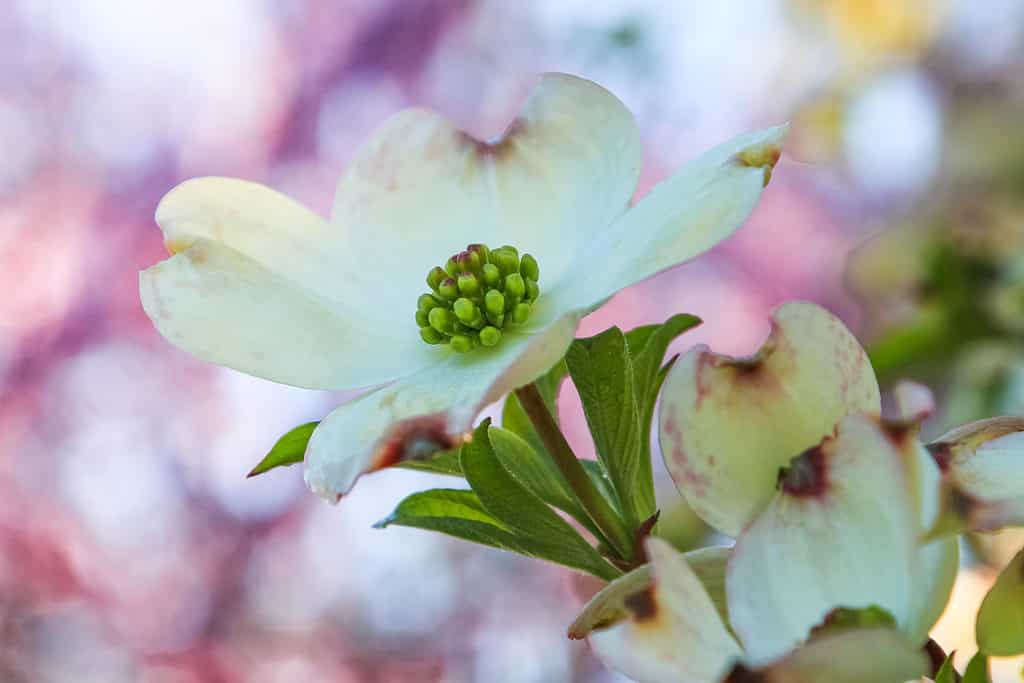
Some dogwood flowers have purple tinges.
©LanaG/Shutterstock.com
Dogwood have light leaves in green shades, which turn to pinkish red in autumn. The leaves are untoothed, with veins curving distinctively toward the leaf margins. Most species have leaves growing in opposites, with some having alternates.
The flowers of the dogwood may come in many shades, including white with green centers, white with yellow centers, pink, dark pink, white with purple tinged edges, white, and variegated. The flowers have four to six petals or petal-like bracts.
The fruit of the dogwood comes in a wide range of colors, sizes, and shapes. Cornelian cherries, for example, are bright red and elongated. Some berries are dark purple to black and round, others are “bumpy” berry-like fruits in pinks and reds.
Origins and History of Dogwood Trees
The dogwood is and has largely been cultivated for its ornamental uses for centuries. The tree grows natively in many areas of the world and is cultivated in much of the world now. North America, eastern Asia, and Eurasia are all home to the lovely tree as a decorative species. However, the tree is also cultivated for traditional medicinal purposes, thanks to the bark being rich in tannins. The bark serves as a substitute for quinine and has been used to treat multiple minor ailments. Of note, in the American Civil War, soldiers would make tea from the bark for treating pain, fever, and as a poultice for wound treatments.
Varieties of Dogwood Trees
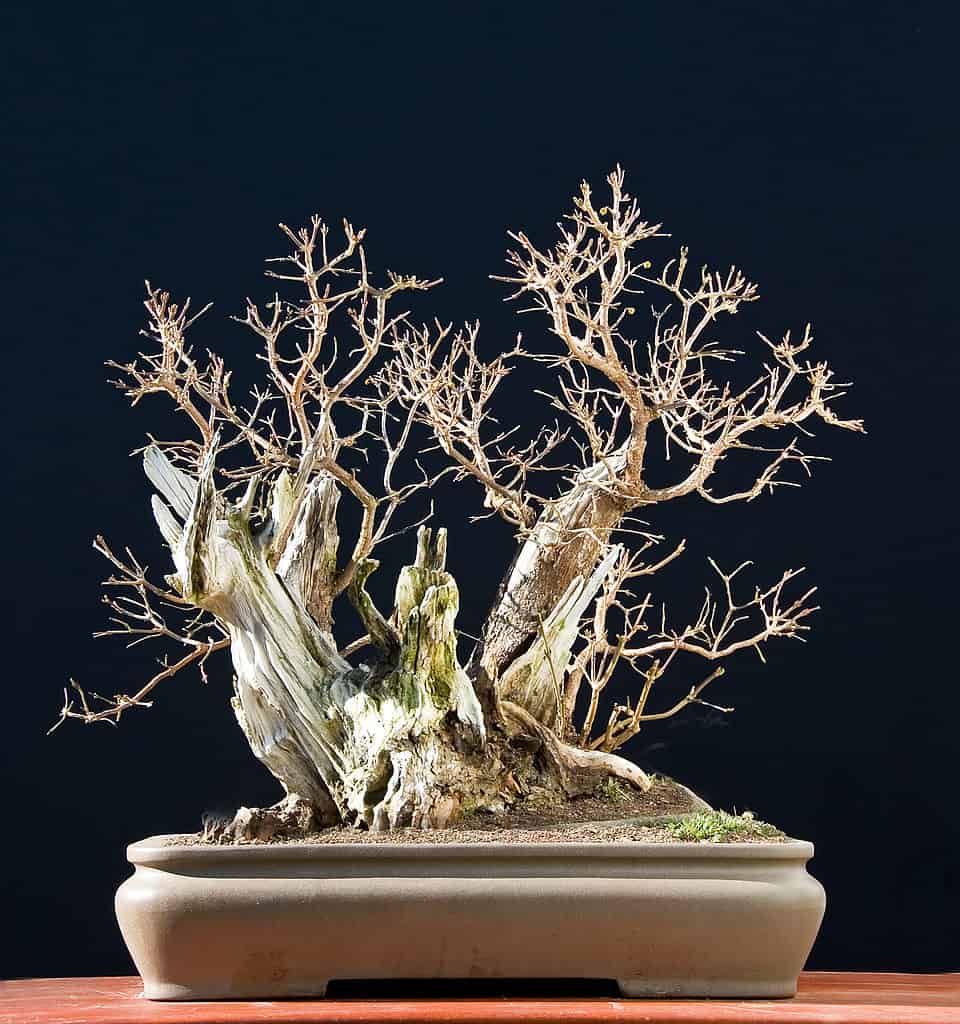
Dogwood are deciduous, meaning they lose their leaves in winter.
©Walter Pall/Shutterstock.com
There are many varieties of dogwood trees, all with similar dark green leaves. The species will determine the color of flower, the fruit, and the size as well. Some of the most popular species include the following.
Chinese Dogwood
This kind of dogwood is, as the name indicates, endemic to China. It produces a small to medium bonsai.
Kousa Dogwood
This species has vibrant, showy blossoms and red or pink fruit. The leaves turn deep red in autumn. It is a fast grower, but it also requires extra care, so it’s not as popular among newer enthusiasts, despite the aesthetic appeal.
Pagoda Dogwood
One of the easiest types of dogwoods to grow, pagodas thrive in partial shade, produces yellow flowers, and blue or black berries.
Red Dogwood
This is another great choice for bonsai as it is a particularly hardy type of dogwood. It does well in a wide range of climates with minimal care. If a beginner is going to try for a dogwood, this would be one of the better choices.
Cornelian Cherry Dogwood
The cornelian cherry is perhaps the popular species for dogwood bonsai. They produce the vibrant, edible fruits and showy flowers.
How to Grow Dogwood as Bonsai

The dogwood tree has blooms in various colors, depending on the cultivar or variety.
©iStock.com/JillLang
Planting Location
Generally speaking, dogwood thrive in partial shade, with a few species preferring full sun. They need proper air circulation, as well, and need shade protection from the hottest sun days. They should be kept outdoors for most of the year. If they are kept indoors, they likely won’t flower nearly as much and may do poorly, largely because their need for sunlight often cannot be met indoors. If you do opt to keep them indoors, keep them in windows, add grow lights, and keep them away from drafty door ways, air vents, heaters, and air conditioners.
And though they do best outdoors, they should be brought indoors in the coldest months, though left outdoors in early winter and early spring. These cold periods are needed for dormancy. When planted in the ground, dogwoods are hardy and can handle colder temperatures, but container living doesn’t provide the trees with the capability of making it through intense winter months outdoors, as pots do not provide the frost protection needed. Ideally, place them in a cold greenhouse or unheated garage. They should not be brought into a warm home.
Lighting
Dogwood bonsai thrive in partial shade to full sun, depending on the species. In most cases, anticipate that they will want partial shade. If, however, you note that the tree isn’t producing a lot of flowers, move the pot to a sunnier spot. They do need protection against particularly hot sunny days. A shade cloth is an excellent choice for this situation if shade is not otherwise easy to come by.
Temperature
Dogwood trees tolerate a fairly wide range of temperatures. They handle warm to hot climates as well as cool to cold. They need shade protection in particularly hot areas and wind and frost protection in particularly cold climates. They need to go through a dormant period, so they should be kept outdoors for most of the year, only coming into cold garages or greenhouses on the worst days.
Watering

The cornelian cherry is a bright red fruit from the dogwood tree.
©iStock.com/RuudMorijn
Dogwoods have a few particular needs when it comes to watering.
- Let the soil dry out completely briefly between watering.
- Mist the leaves throughout the summer to keep the plant humid and moist.
- Do not allow the soil to stay dry for more than a day or two.
- Ensure the pot drains properly to prevent the soil from getting soggy.
- Reduce watering in winter but maintain lightly moist soil.
- For easiest watering, place the bonsai pot into a tub of water that goes higher than the drainage holes and let the plant absorb the water for several minutes before removing.
Feeding
The tree will do well with either a weekly application of liquid bonsai fertilizer or a monthly application of solid organic fertilizer. They should have a balanced fertilizer with NPK ratios that are equal. The liquid fertilizer method is generally easier to control and dilute as needed for bonsai. Start off with a lighter application and increase as needed.
Pruning, Shaping, and Wiring
Dogwood trees are fairly fast-growing trees, with new shoots popping out quickly when springtime hits. The new shoots should be left to grow until four or five nodes appear. Cut them back at that point to one or two leaf pairs and prune the larger branches only after flowering has occurred.
Wire the younger branches in autumn or winter and use guy wires to shape the older, stiffer branches, if needed.
Other tips:
- Only use sharp, sanitized shears for pruning and trimming.
- Focus on the health of the tree first, pruning away what’s necessary, then worry about the shaping of the bonsai.
- Trim off old, dead, or disease branches and segments.
- Don’t go overboard on the trimming. Too much will cause stress for the dogwood.
- During growing season, pinch back new growth to keep the desired shape of the tree.
Re-potting
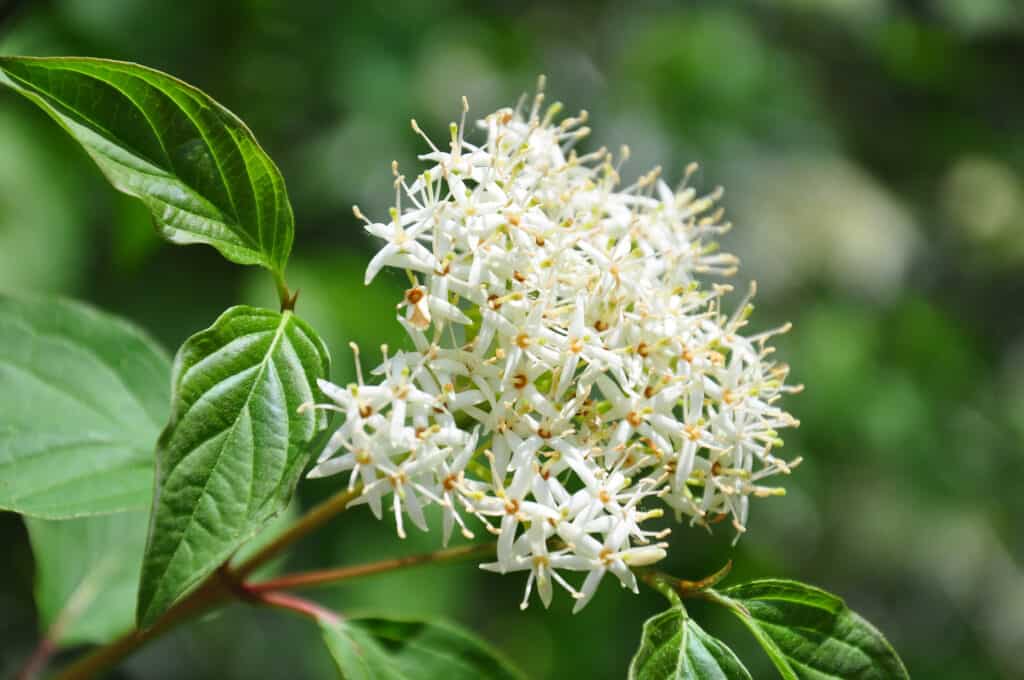
One variety of dogwood (common dogwood) almost looks a bit like jasmine flowers.
©iStock.com/rbiedermann
Younger dogwood bonsai need to be re-potted in early spring every 2 or 3 years. Trim the roots normally at this time, after raking out the soil. Older dogwoods may be re-potted less frequently. Keep an eye out for roots breaking through the drainage holes and ensure they are re-potted if this happens.
As you re-pot, use well-draining soil with a neutral or slightly acidic pH value, unless you’re growing cornelian cherries, which prefer slightly alkaline soil. For cornelian cherries, add limestone gravel.
- Always sterilize the new pot before replacing the dogwood into the pot.
- Use new soil when re-potting to prevent fungus growth or disease from blooming.
- Place a fine mesh screen at the bottom of the pot, then a layer of gravel for drainage. Then add the soil and the tree, filling in soil around the roots.
- Water the tree immediately after re-potting.
- Wait at least 4 weeks before feeding a tree after re-potting.
Common Problems of Dogwood Bonsai Trees

Not all the fruit looks like cherries, though. Some look like unique berries.
©Iryna Imago/Shutterstock.com
Dogwood bonsai are unfortunately prone to several common conditions and pests.
Powdery Mildew
Appearing as a white powdery mess that coast the tree, powdery mildew may cause the leaves of your bonsai to turn yellow or brown. Get rid of this problem with the use of neem oil. Often this situation occurs because the plant doesn’t have enough air circulation. After the neem oil has done its work, ensure the plant has plenty of proper circulation.
Aphids
Tiny insects appear on the underside of the leaves or at the base of the leaves. These are aphids and they can quickly damage the dogwood bonsai. They should be removed manually by gloved hands. Apply a gently pesticide, if the problem persists after their removal.
Ants
Though they probably won’t damage your dogwood bonsai, ants may appear on the tree and signal the infestation of aphids. Ants love to nibble on the dewy insects’ traces. When you rid the tree of aphids, the ants will naturally leave as well.
Spider Mites
Living under the underside of leaves, mites may infest and quickly damage your bonsai. You’ll notice tiny white spots on the leaves. To get rid of them, use a gentle, nontoxic insecticide or a mixture of dish soap and water. Wash the plant gently with cotton swabs and rubbing alcohol to finish the job. Repeat again 24 hours later.
Scale
These insects appear as bumps on the stalk and branches of the dogwood bonsai. They are called “scale” because of the hard outer shells they have that protect them. They may be brown, tan, white, or almost black. Typically, they appear a handful at a time. If you notice the bumps, manually remove them with a cotton swab and rubbing alcohol. For larger infestations, use neem oil or gentle, nontoxic pesticides.
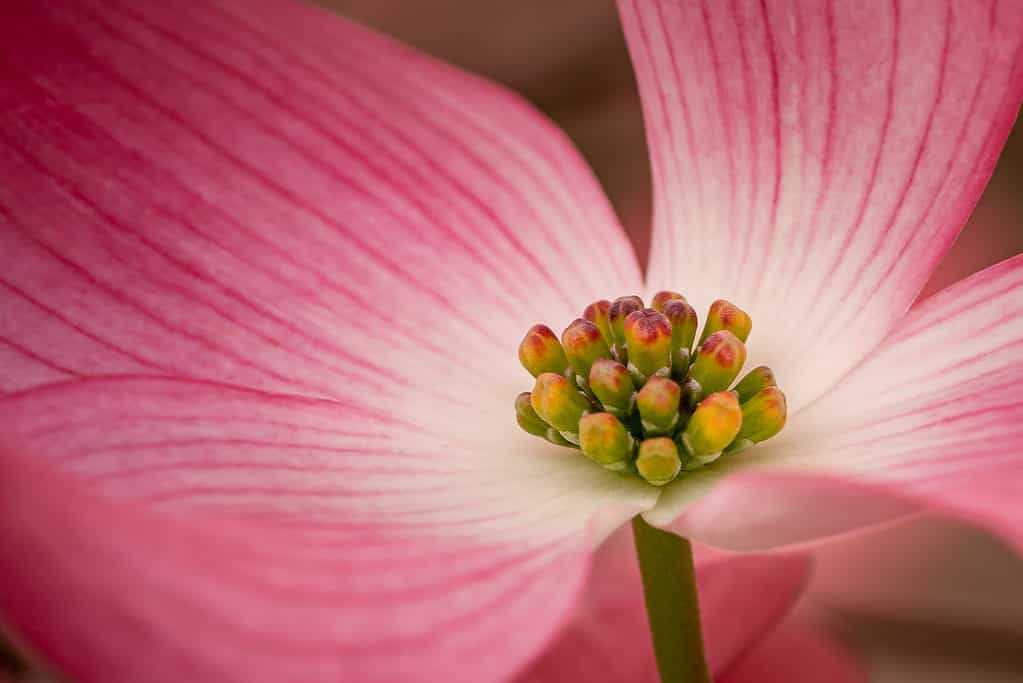
The dogwood flower may come in many shapes and colors.
©d murk photographs/Shutterstock.com
How to Propagate Dogwood Bonsais
Many folks prefer to purchase established dogwood bonsai trees to make growth easier. However, there are two primary ways to propagate dogwood bonsai, from cuttings and from seeds.
Growing Dogwood Bonsai from Seeds
Before we begin, it should be noted that cornelian cherries take 2 years to germinate from seed, only after they are exposed to frost. It should also be noted that hybrid dogwood do not produce seeds that will propagate.
- If you’re gathering seeds from dogwoods, collect them in mid to late autumn.
- In early winter, prepare to plant the seeds.
- Use a shallow container or pot, with high-quality bonsai soil or seed starter growing medium.
- Scatter the seeds over the medium and then press them into the soil.
- Cover the seeds with about a quarter of an inch of soil.
- Water the seeds and keep the container in a cool environment, between 35 and 41-degrees F.
- Gradually increase the temperature with a heating pad, raising it to between 60 and 80-degrees F.
- Keep the seeds moist throughout.
- When the seedlings hit 4 inches in height, gently transplant them into the starter bonsai containers.
Growing Dogwood Bonsai from Cuttings
Many folks prefer using cuttings because they know what the dogwood will look like, since cuttings from the mother plant produce the “same” tree, while seeds may vary.
- Cut young branches from the mother tree in summer. Make sure the cutter is sanitized.
- Cut branches that have at least one leaf node. Ideally, take several cuttings to help ensure at least one will root properly.
- Apply rooting hormone to the cut ends.
- Plant the cut ends into a mixture of 1 part bonsai soil, 1 part regular soil. Plant 1 cutting per container, burying the cutting about halfway.
- Water the cuttings immediately.
- Maintain water levels for the next 4 to 8 weeks, giving them time to take root.
- Once the plants take root, you may move them into larger pots.

A full-sized dogwood shape can easily be emulated in bonsai size.
©Virunja/Shutterstock.com
Dogwood Bonsai FAQs
Should dogwood bonsai be grown indoors or outdoors?
Dogwoods thrive as outdoor bonsai. They should rarely, if ever, be brought indoors. They need the dormancy periods that winters provide them and loads of sunlight.
How long do dogwood bonsai take to grow?
The maturation rate of dogwood bonsai will vary, depending on the species. For example, the cornelian cherry takes at least 2 years for the seed to germinate. However, once seeds do germinate, most are fairly fast growers. Cuttings take several weeks to take root, and seedlings may take some time, but once they do, if they receive appropriate care, they will take off.
Up Next:
Thank you for reading! Have some feedback for us? Contact the AZ Animals editorial team.

